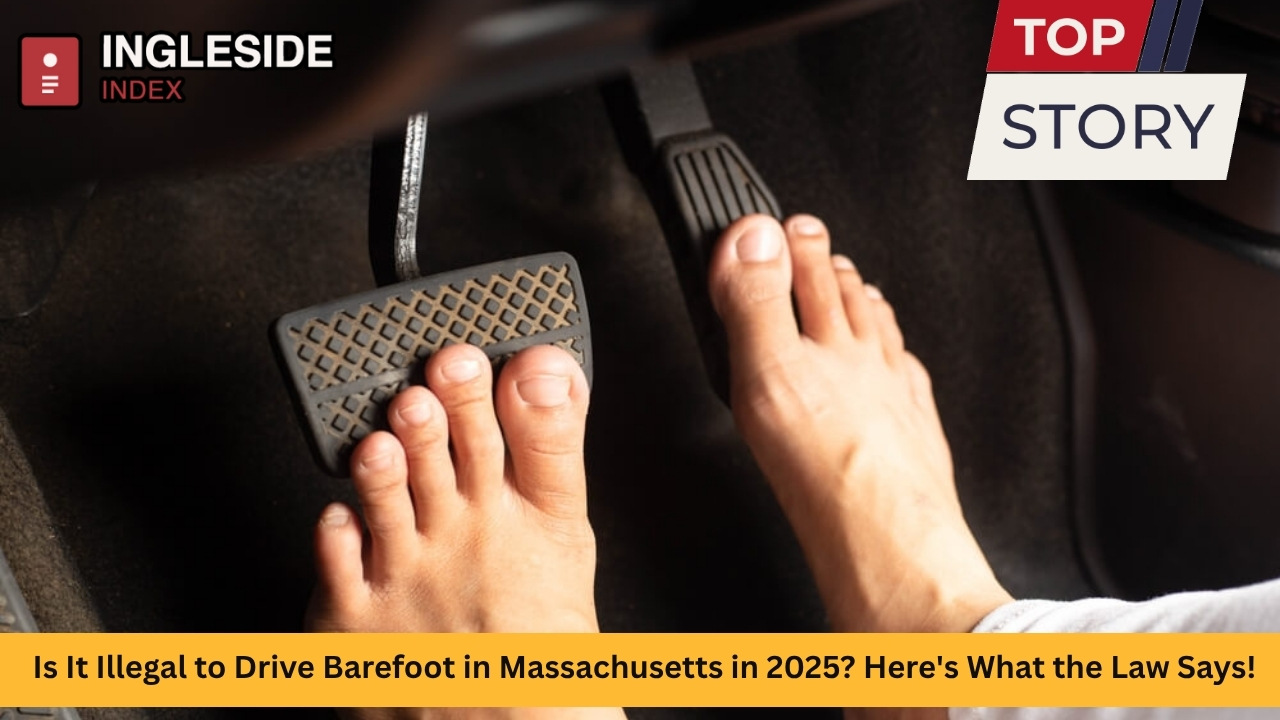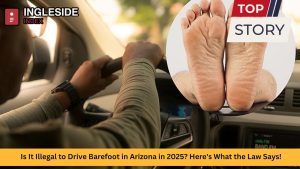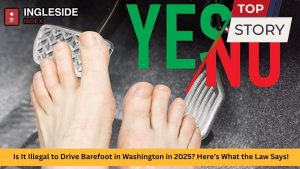The warm summer months in Massachusetts bring beach trips to Cape Cod, drives along the scenic Mohawk Trail, and countless opportunities to kick off those confining shoes. Whether you’re cruising through Boston’s bustling streets or taking a leisurely drive through the Berkshire Mountains, the question of barefoot driving inevitably arises. Can you legally drive without shoes in the Bay State? The answer might surprise you.
The Straight Answer: No, It’s Not Illegal
Driving barefoot is completely legal in Massachusetts in 2025. This fact often shocks many drivers who have grown up believing that operating a vehicle without shoes is against the law. The truth is, there is no specific statute in the Massachusetts General Laws that prohibits driving without footwear.
This legal reality extends beyond Massachusetts borders. In fact, no state in the entire United States has laws that explicitly ban barefoot driving. This nationwide legal consensus has been consistent for decades, despite persistent myths suggesting otherwise.
The Great Barefoot Driving Myth: How It Started
The misconception about barefoot driving being illegal is so widespread that it has become one of America’s most enduring driving myths. In 1994, a researcher named Jason Heimbaugh decided to get to the bottom of this persistent belief. He systematically contacted the Department of Motor Vehicles in all 50 states, including Washington D.C., asking about their barefoot driving laws.
The results were definitive: every single state confirmed that driving barefoot is legal. Despite this comprehensive research being conducted over 30 years ago, the myth persists, with many Massachusetts drivers still believing they could receive a ticket for driving without shoes.
What Massachusetts Law Actually Says
Massachusetts driving regulations focus on the operator’s ability to safely control the vehicle. The state’s traffic laws, found in Chapter 90 of the Massachusetts General Laws, emphasize driver competency and safe operation rather than specific footwear requirements.
The closest Massachusetts comes to addressing footwear is through general safety provisions that require drivers to operate their vehicles in a manner that doesn’t endanger public safety. The law requires that drivers wear clothing and footwear that “does not prevent you from using the controls in the correct manner.”
This means that while barefoot driving itself isn’t illegal, if your lack of shoes contributes to an accident or unsafe driving, you could potentially face charges related to reckless or negligent operation of a motor vehicle.
Safety Considerations: The Real Debate
While the law may be clear about the legality of barefoot driving, safety experts and driving instructors have varying opinions about whether it’s a good idea. The debate centers around several key factors that every Massachusetts driver should consider.
Arguments in Favor of Barefoot Driving
Many driving safety experts argue that barefoot driving can actually be safer than wearing certain types of shoes. Here’s why:
Better Pedal Feel: Bare feet provide direct contact with the pedals, allowing for more precise pressure control. This enhanced sensitivity can be particularly beneficial when navigating Boston’s stop-and-go traffic or making emergency stops on Route 128.
No Shoe Interference: Unlike flip-flops, high heels, or loose-fitting shoes, bare feet cannot get caught under pedals or slip off at crucial moments. This eliminates the risk of footwear-related pedal interference that has been known to contribute to accidents.
Consistent Contact: Bare feet maintain consistent contact with the pedal surface, providing reliable feedback about pressure and position. This consistency can be especially valuable during long drives across Massachusetts, such as traveling from Springfield to Boston.
Arguments Against Barefoot Driving
However, there are legitimate concerns about driving without shoes:
Reduced Protection: In the event of an accident, bare feet offer no protection against broken glass, twisted metal, or other debris. This vulnerability could lead to serious injuries that might prevent a driver from evacuating a vehicle safely.
Weather Considerations: Massachusetts winters can be particularly harsh, and bare feet in cold conditions could lead to numbness or reduced sensitivity. Even during summer months, air conditioning can make feet cold and less responsive.
Slippery Conditions: Wet or sandy feet from a day at Crane Beach or Martha’s Vineyard could create slippery conditions on the pedals, potentially reducing control during critical moments.
Insurance and Legal Implications
While barefoot driving isn’t illegal in Massachusetts, it can have implications for insurance claims and legal proceedings following an accident.
Insurance Considerations
If you’re involved in an accident while driving barefoot, insurance companies will investigate all contributing factors. While barefoot driving alone won’t void your coverage, if investigators determine that your lack of shoes contributed to the accident, it could affect your claim.
Massachusetts operates under a modified comparative negligence system, meaning that if you’re found partially at fault for an accident, your compensation could be reduced proportionally. If barefoot driving is deemed a contributing factor, it could impact the final settlement.
Legal Ramifications
In legal proceedings following an accident, barefoot driving could be presented as evidence of negligent behavior. While it’s not illegal, prosecutors or opposing counsel might argue that driving without shoes represents a failure to exercise reasonable care.
Massachusetts courts would evaluate barefoot driving within the context of the specific accident circumstances. Factors like weather conditions, time of day, and the driver’s overall behavior would all be considered.
Alternative Footwear Options
For Massachusetts drivers who want the benefits of barefoot driving without the potential risks, several alternatives exist:
Driving Shoes
Specialized driving shoes, available at many Massachusetts retailers from Boston to Springfield, are designed with thin, flexible soles that provide barefoot-like sensitivity while maintaining protection. These shoes often feature heel padding to prevent slipping and are designed specifically for pedal operation.
Minimalist Footwear
Ultra-thin soled shoes or driving moccasins offer a compromise between barefoot sensitivity and foot protection. Many drivers find these options ideal for summer driving throughout Massachusetts.
Sock-Only Driving
Some drivers opt for thick, non-slip socks when driving. While still not providing foot protection, socks can offer some grip and warmth while maintaining much of the sensitivity of barefoot driving.
When Barefoot Driving Makes Sense
Certain situations make barefoot driving not just acceptable but potentially preferable:
After Beach Days: Following visits to popular Massachusetts beaches like Singing Sands in Manchester-by-the-Sea or Race Point Beach in Provincetown, driving barefoot eliminates the discomfort of sandy shoes.
Hot Weather Driving: During Massachusetts heat waves, particularly in urban areas like Boston where pavement temperatures soar, barefoot driving can be more comfortable than wearing hot, restrictive shoes.
Medical Conditions: Some foot conditions, injuries, or medical devices make wearing traditional shoes uncomfortable or impossible. In these cases, barefoot driving may be the safest option.
Short Local Trips: Quick drives around neighborhoods in cities like Salem, Lowell, or Fall River may not warrant putting on shoes, especially for errands like checking the mail or moving a car.
Seasonal Considerations in Massachusetts
Massachusetts’ distinct seasons create different considerations for barefoot driving:
Spring and Summer
Warm weather months from May through September represent peak barefoot driving season. Beach trips, outdoor activities, and general warm weather comfort make shoeless driving common throughout the state.
Fall
Cooler temperatures and unpredictable weather in autumn make barefoot driving less appealing. The beauty of Massachusetts fall foliage drives is best enjoyed with proper footwear for warmth and safety.
Winter
Massachusetts winters make barefoot driving inadvisable for obvious reasons. Cold temperatures, snow, ice, and the need for potentially rapid vehicle evacuation make proper footwear essential during winter months.
The Bottom Line for Massachusetts Drivers
The definitive answer for Massachusetts drivers is clear: barefoot driving is legal in 2025 and will likely remain so for the foreseeable future. No law enforcement officer can ticket you simply for not wearing shoes while driving.
However, legality doesn’t automatically equal safety or wisdom. Massachusetts drivers should consider their specific circumstances, including:
-
Current weather and road conditions
-
Type of driving (city vs. highway vs. rural)
-
Length of trip
-
Personal comfort and control
-
Potential safety implications
Conclusion
The persistent myth that barefoot driving is illegal in Massachusetts has been thoroughly debunked. In 2025, as in previous years, Massachusetts drivers are free to operate their vehicles with or without shoes, provided they can do so safely.
The key takeaway for Bay State drivers isn’t whether barefoot driving is legal—it definitively is—but whether it’s the safest choice for your specific driving situation. Whether you’re navigating Boston’s complex road system, enjoying a scenic drive through the Berkshires, or heading home from a day at the beach, the most important factor is your ability to maintain safe control of your vehicle.
By understanding both the legal reality and the safety considerations surrounding barefoot driving, Massachusetts drivers can make informed decisions that prioritize both comfort and safety on the state’s diverse roadways. Remember, while you won’t get a ticket for driving barefoot, you remain responsible for operating your vehicle safely regardless of your footwear choice.
The freedom to drive barefoot is just one of many personal choices Massachusetts law leaves to individual drivers, reflecting the state’s approach of emphasizing safe driving practices over rigid footwear regulations.
- https://tomkileylaw.com/driving-barefoot-in-massachusetts/
- https://www.sweeneymerrigan.com/blog/is-it-legal-to-drive-barefoot-in-massachusetts/
- https://www.thezebra.com/resources/driving/driving-barefoot/
- https://www.consumershield.com/injuries-accidents/car-accidents/illegal-drive-barefoot
- https://www.mass.gov/doc/english-drivers-manual/download
- https://wbsm.com/massachusetts-rhode-island-driving-barefoot/
- https://1800lionlaw.com/is-it-illegal-to-drive-barefoot/
- https://insurify.com/car-insurance/knowledge/is-it-illegal-to-drive-barefoot/
- https://live959.com/is-it-illegal-to-drive-in-flip-flops-in-massachusetts/
- http://tomkileylaw.com/driving-barefoot-in-massachusetts/
- https://wbsm.com/massachusetts-barefoot-laws/
- https://www.reddit.com/r/massachusetts/comments/13yipj3/is_it_legal_to_drive_with_a_boot_on_your_left/




